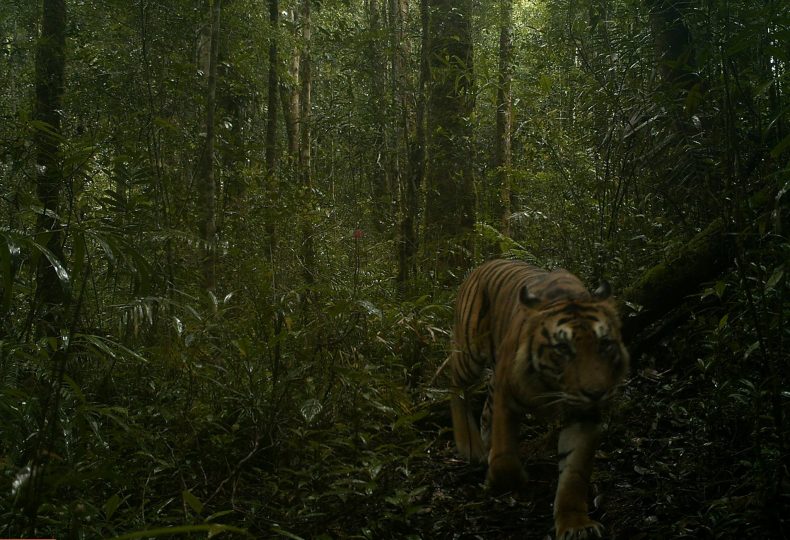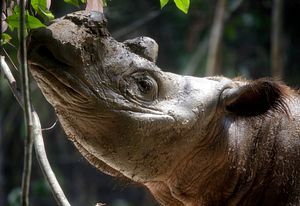The Chinese were among the first foreigners to do trade with the island of Sumatra. Six hundred years ago, villages would have been but infinitesimal specks in an inconceivably vast and sublime rain forest. In 1416, a Chinese report on Sumatra noted that “There are in the forests immense quantities of wild rhinoceroses, which the king lets catch by men.” The rhinos, the author goes on to explain, would be sent to China as “tribute” to the emperor. Later, in the midst of compiling a list of agricultural products and minerals to be found in Sumatra, the author’s mind drifts back to something even more valuable, and he abruptly ends his list by reminding his Chinese reader: “Besides, there are rhinoceroses.”
There are still rhinoceroses in Sumatra today, perhaps as few as 30, and they are still hunted. According to that 15th century Chinese account, as well as the testimony of early European visitors and explorers, rhinoceroses once swarmed on the island. Yet their population has all been but wiped out. What happened?
The answer is pretty straightforward: They were hunted and slaughtered for their horns. Many of those horns were sent to China, where they were used in so-called traditional medicine. The trend continues to this day, and it will continue until the last rhino has been hunted out of Sumatra’s protected areas.
Once found from northeastern India to the Indonesian island of Java, the one-horned Sumatran and Javan rhino species are now reduced to three or four forested pockets on Sumatra, Java, and Borneo. And it is the Chinese — as well as Vietnamese — demand for rhino horn (which is, in fact, nothing but keratin — the same substance as your fingernails) that is driving the ghastly poaching trend that has all rhino species on the path to extinction. The last Javan rhino of Vietnam was poached for its horn in Cat Tien National Park in 2011, and Javan rhinos are now found only in one national park in far western corner of Java. Rhinoceroses are almost certainly extinct in Sarawak today, and the last one of Sabah state in Borneo is ill.
It is important to understand that long before wildlife conservation groups were ever formed, the Chinese were already rapidly depleting rhinoceroses in Southeast Asia. Rhinoceroses on Borneo suffered terribly from the demand for their horns by Chinese economic migrants in the state of Sarawak as far back as the early 1800s. In Daniel Chew’s book Chinese Pioneers on the Sarawak Frontier 1841-1941, mention is frequently made of Ibans and Dayaks hunting rhino horn — and other valuable “exotic jungle” products such as bezoar stones from the stomachs of monkeys — for Chinese shopkeepers in Kuching and jungle river outposts.
And paying the natives to go hunting wasn’t a mere backwater business deal, as Chew explains:
The relentless extraction of jungle products by the indigenous population for sale to Chinese traders transformed the riverine economies from self-contained economies based on subsistence farming into those based on exchange and inextricably linked with external markets, and with increasing sophistication in the use of money.
A similar story can be told about another species of Asian megafauna: Tigers. In the 19th century vast swaths of Sumatra and Java were “infested” with tigers, which would pick off mailmen and laborers wandering around the backroads and the edges of plantations and carry them off into the jungle for dinner. Natives built high spiked palisades around their dwellings to keep tigers out. During the clearing of the forests and swamps of what is now Singapore, it is said that a person would be carried off daily by tigers. In the 1930s, French Captain Henry Baudesson, overseeing the construction of a railway in southern Vietnam, wrote that the tiger’s “supremacy has hardly yet been seriously challenged” in the hinterlands, adding, “In Indo-China the tiger is the hunter and man the hunted.” Big cat expert Alan Rabinowitz tells us that in the 1920s two tigers strolled down from the mountains and right into downtown Rangoon near the Shwedagon Pagoda, where they were shot and killed. In what is now the Si Phon Don or “Four Thousand Islands” in southern Laos, tigers would stalk fishermen who plied their trade, and in the 1980s villagers in Ratanakiri province in Cambodia dared not wander outside the torch-lit boundaries of their thatched villages at night for fear of being pounced on by tigers.
It is estimated that there were 100,000 tigers in the wild in 1900; today their numbers are down to about 3,200. The Javan tiger was declared extinct in the 1980s; the last tiger of China’s Yunnan province was snared and eaten by a poacher in 2009.
Where did all those tigers go? Some were killed by farmers in retaliation for livestock predation, but the main reason lies elsewhere: China. China is by far and away the main consumer of tiger parts: whiskers, fur, claws, teeth, meat, and, most of all, penis, which is highly sought after by those seeking “traditional” cures for erectile dysfunction and other ailments. This “natural Viagra” is based on the concept of imitative magic — consume a part of the animal that carries out a particular function and your body will absorb this element and put it to use in the same way. Tigers can have sex up to 25 times a day, and many a Chinese tiger penis consumer entertains dreams of being a superman stud based on this information. What the Chinese medicine doctors almost certainly fail to convey to their big-spending customers is that each bout of tiger sex only lasts from two to ten seconds.

A tiger photographed by a camera trap in Sumatra. Image courtesy of Gregory McCann.
Helmeted hornbills (Rhinoplax vigil) once made the rainforest canopies of Borneo and Sumatra shudder from the heavy swooping of their wings. Males would collide in mid-air as they vied for dominance, giving one another a massive clacking casque-bash (headbutt) that resounded over the canopy (this act has been seen but never recorded). When the Chinese began trading with the Dayaks of Borneo centuries ago, aside from rhino horn, one of the most prized products from Sarawak was the “red ivory” from helmeted hornbill casques. In recent times, Taiwanese and Chinese businessmen have been driving a horrid poaching trend across this bird’s range, and in a few short years its International Union for Conservation of Nature (IUCN) status plummeted from Vulnerable to Critically Endangered. Again, all roads lead to China, and this time to Guangdong warehouses, where thousands of the birds’ decapitated heads sit in storage bins waiting to be carved into jewelry boxes and other trinkets.
Asian elephants have been ruthlessly slaughtered for their ivory across Asia for years, and their numbers are declining. Habitat destruction is probably the key driver for this megafauna’s demise, and their African cousins have it worse due to the fact that their tusks are much bigger and therefore more valuable, but Asian elephants have it bad too. There is thought to be just one or two wild herds remaining in Vietnam, numbering no more than 60 individuals, and several elephants across the border in Cambodia’s Mondulkiri province have been found dead with their tusks sawed off in what might be a troubling new trend in the Kingdom. In the eastern Thai provinces of Rayong and Changseao, local media report almost daily on human-elephant conflicts, and in Myanmar wild elephants are being killed for their skin, which is used to make clothing, jewelry, and, of course, traditional medicine. These products are sold in the border town of Mong La and virtually all of the customers are from China. Elephants were once found as far north as the outskirts of Beijing, but Chinese farmers and elephants don’t get along, and the pachyderms were pushed south or simply killed. In Mark Elvin’s brilliant The Retreat of the Elephants, mention is made of Chinese recipes for barbecued elephant trunk.
A large cache of wildlife parts was discovered in the Chinese Chamber of Commerce in Phnom Penh in 2014, a bust that demonstrates Chinese complicity in the wildlife trade in Cambodia at a very high level. Among the haul were tiger skins, bear paws, otter skins, and the pelts of 19 clouded leopards. In fact, as tigers become more and more scarce, poachers may be targeting clouded leopards as a replacement. The scope and magnitude of this dismal feedback cycle are not completely known, but the situation is almost certainly far worse than we know. During the 1980s and 1990s it is estimated that 100 tigers a year were being poached from Cambodia’s forests and sold to Chinese in Phnom Penh and in Bangkok. Under similar circumstances, it wouldn’t take long for clouded leopards to disappear from Cambodia, just as tigers already have.
Many of these animals are targeted because they have the misfortune of being listed in the classic Chinese text, Ben Cao Gang Mu 《本草纲目》or Compendium of Materia Medica. Tigers, rhinos, bears (for their bile), pangolins (three tons of pangolin scales were recently intercepted by Chinese police in the biggest bust ever), sharks, manta rays, seahorses (8 million in one haul), sea turtles — the list of at-risk species is damning. In a particularly gruesome example, macaques have been known to be cooked alive for the consumption of their brains in Hong Kong and Guangdong.
If all of this seems a bit overwhelming, rest assured that it’s just the tip of the iceberg. There is an all-out war against wildlife in Southeast Asia, and beyond, and it can be traced to China, and to a lesser extent, Vietnam and Laos (and in Boten in northern Laos, the casino/tiger farm/anything-goes fun park is run by the Chinese; in fact, China has a 99-year lease on the land).
Wherever large numbers of Chinese workers are brought in to work on infrastructure projects, an uptick in poaching usually follows. This is true in as far-flung places as Bolivia, where a demand for jaguar fangs has been spurred by local Chinese. What’s going to happen to the wildlife in Central Asia and Eurasia if the Belt and Road Initiative really gets going?
We are now in the Anthropocene Era, where the face of the planet is being rapidly transformed by man and wild ecosystems and wild animals are disappearing at a hundred or even a thousand times faster than the natural rate. And nowhere is this more apparent than in Southeast Asia, where the remaining forests are being diced up by roads and other infrastructure projects. Usually, no one knows when the last of a species dies and goes at least locally — if not utterly — extinct.
I have conservation projects in Sumatra and Cambodia, two of the most difficult places in the world to do conservation. It is very difficult to be optimistic, at least in these places. Rhinoceroses went extinct in Cambodia about 65 years ago, with the last one photographed in Kampong Cham province not far from the Mekong River in the 1950s. I can almost see the sparkle in that long-ago Chinese chronicler’s eye when he wrote: “Besides there are rhinoceros.” Too many people in China today still have that sparkle in their eye, and every tiger, rhinoceros, and elephant has got a bullet or a snare with its name on it.
Progress has been made, and people like Yao Ming deserve massive credit for efforts to persuade China to ban the ivory trade in the mainland. But more needs to be done, and fast, before it’s too late.
Gregory McCann is the Project Coordinator for Habitat ID and the author of the book Called Away by a Mountain Spirit.

































